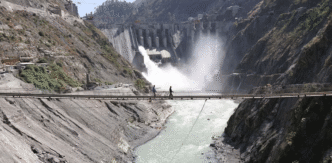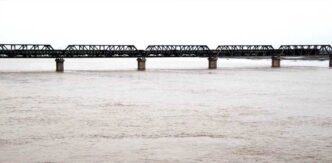India Releases Water into Sutlej River, Triggering High Flood Alert in Punjab
LAHORE, PUNJAB – Pakistan’s Punjab province faces an imminent flood threat as India released additional water into the Sutlej River on September 7, 2025, exacerbating existing monsoon-driven flooding and prompting urgent evacuations in downstream regions .
🌊 Immediate Impact and Current Situation
Sutlej River Swelling:
Water levels at the Ganda Singh Wala monitoring station reached 303,828 cusecs, classified as an “exceptionally high flood” .
The Jalaldinwala embankment was breached, submerging 10 villages in Kasur district (e.g., Fatohiwala, Chohriwala) and endangering crops .
Evacuations and Rescue Efforts:
70,000 people and 169,000 livestock have been evacuated from flood-hit areas as of September 1 .
Rescue operations are ongoing, with teams mobilised in Kanganpur and other vulnerable zones .
⚠️ Causes and Contributing Factors
Indian Water Releases:
India’s Bhakra and Pong dams, nearing full capacity due to heavy monsoon rains in Himachal Pradesh and Punjab, necessitated controlled releases .
The Indian High Commission issued flood alerts to Pakistan via diplomatic channels on “humanitarian grounds” but withheld detailed hydrological data under the suspended Indus Waters Treaty .
Monsoon Intensity:
Punjab received 74% above-normal rainfall in August 2025, saturating river catchments and reducing natural absorption capacity .
Concurrent releases from Indian dams (e.g., Bhakra, Pong) coincided with local rainfall, amplifying downstream flows .
🚨 Regional Risks and Official Response
Critical Zones:
Multan: A flood wave from Head Trimmu is expected within 48 hours, stressing embankments along the Chenab River .
Ludhiana: Embankments weakened under strong currents, threatening villages like Sasrali and Boothgarh .
Government Actions:
Punjab’s Provincial Disaster Management Authority (PDMA) issued high alerts for Sutlej and Chenab rivers, warning of flash floods in Dera Ghazi Khan .
Relief camps (506), medical facilities (352), and veterinary services have been established across affected districts .
📊 Broader Context and Controversies
Indus Waters Treaty Breakdown:
India suspended data sharing after the April 2025 Pahalgam attack, complicating cross-border flood coordination .
Pakistani officials (e.g., Minister Ahsan Iqbal) accuse India of “water aggression,” claiming releases were timed to maximize damage .
Expert Perspectives:
Hydrologists argue that dam releases are a necessary safety measure during extreme rainfall, not a deliberate weapon .
Climate change has rendered historical dam design parameters “obsolete,” increasing spillage needs .
🔮 Outlook and Recommendations
Short-Term:
The PDMA forecasts persistent flood conditions for 72 hours, with Sutlej flows potentially exceeding 800,000 cusecs at Head Panjnad .
Continued monitoring at major barrages (e.g., Guddu, Sukkur) is critical as water moves toward Sindh .
Long-Term:
Revive bilateral dialogue under the Indus Waters Treaty to restore data sharing and cooperative flood management .
Invest in real-time monitoring infrastructure and community-based early warning systems .
💎 Conclusion
The Sutlej flood crisis underscores the interplay between climate extremes, transboundary water politics, and infrastructural vulnerabilities. While immediate rescue efforts prioritize lives, sustainable solutions require reconciling diplomatic tensions with adaptive water governance. Pakistan’s disaster management agencies remain on high alert, leveraging limited warnings to mitigate losses amid escalating regional challenges .
For real-time updates, refer to the advisories.
Source







